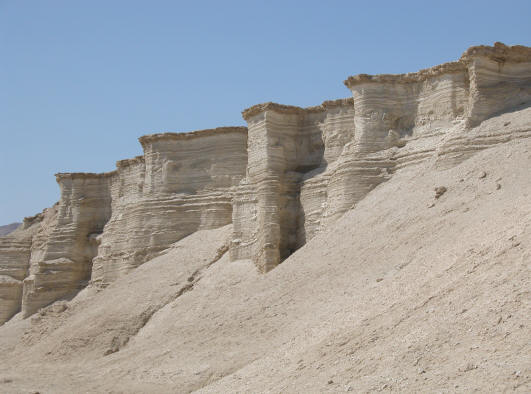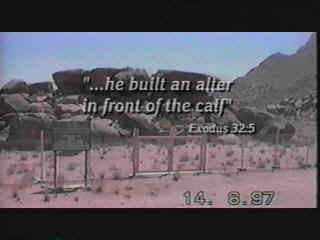Discoveries of biblical artefacts and places
Sodom and Gomorrah
The Red Sea Crossing
Noah's Ark
Research on Joseph in the ancient Egypt
The crucifixtion of Christ and the Ark of the Covenant
The real Mt.Sinai in Saudia Arabia
All themes with video!
We live in a time, where the people call for a “New World Order”. A new world, there is no place for a living God, who is the creator of the world.
But the bible is true. There is written:
For the invisible things of him since the creation of the world are clearly seen, being perceived through the things that are made, [even] his everlasting power and divinity; that they may be without excuse: (Romans 1:20).
And here we have also biblical, archaeological evidences.
No man can say “There is no God”.

The cities of the plain were destroyed as a warning for all that this same event will happen again one day to the wicked. One would think God is capable of preserving this ancient lesson for us to see and to learn from.
"Then the Lord rained brimstone and fire on Sodom and Gomorrah, from the Lord out of the heavens" Genesis 19:24. "Turning the cities of Sodom and Gomorrah into ashes, condemned them to destruction, making them an example to those who afterward would live ungodly" II Peter 2:6. (The word for "example" means an exhibit for warning.)
The rest of the city including ziggurat and sphinx (they shall protect)
Ninety degree angles extending out from a wall demonstrating unnatural architecture. God rained down upon these cities was so hot that it burned the limestone blocks that were used in the construction of the cities. The ash there today is composed of Calcium Sulfate and Calcium Carbonate which are by-products of the limestone and sulfur burning.
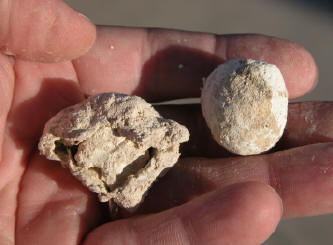 |
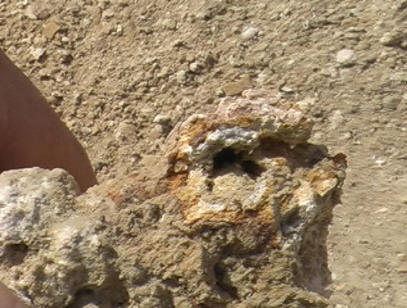 |
| Each of the cities of the plain contain evidence of brimstone which God rained down upon the cities to destroy them. The brimstone is composed of 96-98 percent sulfur, with trace amounts of magnesium which create an extremely high temperature burn. This is the only place on earth where you can find 96 percent pure monoclinic sulfur in a round ball. This brimstone is NOT from any type of geo-thermal activity as there is no evidence of such in the area, and geo-thermal sulfur nodules are only 40 percent pure sulfur and are of the rhombic type. | |
For more text, facts and pictures, please visit the adress at the end of this page.
Back to the top
The Red Sea Crossing

There is a traditional route of the Exodus which has the children of Israel wading in shallow water through an area north of the Gulf of Suez while the tide was out. This area cannot be the crossing site as it does not match the biblical account. A shallow area of water could not drown all of the Egyptian army. Also, they were to leave Egypt proper before encountering the Red Sea crossing.

A gilded chariot wheel that remains on the sea floor. It was found by Ron Wyatt using a molecular frequency generator from his boat above, after he set the equipment to search for gold. The Bible said all the chariots of Egypt and 600 choice chariots, or gold veneered models, were in the army pursuing God's people.
For more text, facts and pictures, please visit the adress at the end of this page
Back to the top
Noah's Ark

These are the generations of Noah: Noah was a just man and perfect in his generations, and Noah walked with God. And Noah begat three sons, Shem, Ham, and Japheth. The earth also was corrupt before God, and the earth was filled with violence.
And God looked upon the earth, and, behold, it was corrupt; for all flesh had corrupted his way upon the earth.
And God said unto Noah, The end of all flesh is come before me; for the earth is filled with violence through them; and, behold, I will destroy them with the earth.
Make thee an ark of gopher wood; rooms shalt thou make in the ark, and shalt pitch it within and without with pitch. And this is the fashion which thou shalt make it of: The length of the ark shall be three hundred cubits, the breadth of it fifty cubits, and the height of it thirty cubits.
Genesis 6:9-15
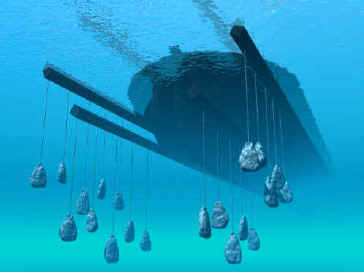
Underwater view of ark carrying the large anchor stones.
 |
 |
| Michelson: "The Epic of Gilgamesh that makes reference to 'You can't cross the waters without the stone things.' What are they talking about? They're talking about the sea anchors." | |
A warning of Jesus Christ for this end time today:
"And as [were] the days of Noah, so shall be the coming of the Son of man.
For as in those days which were before the flood they were eating and drinking, marrying and giving in marriage, until the day that Noah entered into the ark,
and they knew not until the flood came, and took them all away; so shall be the coming of the Son of man."
Mat. 24:37-39
For more text, facts and pictures, please visit the adress at the end of this page
Back to the top
Reasearch on Joseph in the ancient Egypt
A first part of the story of Joseph, You can read it in the Bible in Genesis 39:1 - 41:46

When excavations were carried out at the Step Pyramid at Sakkara, fragments of a statue of pharaoh Djoser were found. The base was inscribed with the names of Djoser and of ...
- "Imhotep, Chancellor of the King of Lower Egypt, Chief under the King, Administrator of the Great Palace, Hereditary Lord, High Priest of Heliopolis, Imhotep the Builder, the Sculptor, the Maker of Stone Vases..."
Inscription showing the name and titulary of Imhotep ![]() in the 3rd row to the left, and the Horus-name of Djoser. This inscription was found on the base of a sculpture of Djoser, thus indicating Imhotep was a real man, as opposed to a god.
in the 3rd row to the left, and the Horus-name of Djoser. This inscription was found on the base of a sculpture of Djoser, thus indicating Imhotep was a real man, as opposed to a god.
Does this fit what we know of Joseph? The Bible is quite clear on his high rank under the pharaoh:
- "Thou shalt be over my house, and according unto thy word shall all my people be ruled: only in the throne will I be greater than thou. And he made him to ride in the second chariot which he had; and they cried before him, Bow the knee: and he made him ruler over all the land of Egypt. And Pharaoh said unto Joseph, I am Pharaoh, and without thee shall no man lift up his hand or foot in all the land of Egypt." Genesis 41:40-44

Amazing inscription found carved on a large rock on the island of Sihiel. Content of the inscription:
- 1. The inscription begins with the great distress of the pharaoh: "I was in distress on the Great Throne..." The Bible: "And it came to pass in the morning that his spirit was troubled" GEN 41:8
- 2. In the inscription, the pharaoh is troubled about a famine and asks Imhotep who the god of the Nile is, so he can approach him about the drought: "... I asked him who was the Chamberlain,...Imhotep, the son of Ptah... `What is the birthplace of the Nile? Who is the god there? Who is the god?'" Imhotep answers: "I need the guidance of Him who presides over the fowling net,..." The Bible: "And Joseph answered Pharaoh, saying, It is not in me: God shall give Pharaoh an answer of peace." Genesis 41:16
In the Egyptian text above, Imhotep is termed "the son of Ptah", who was the Egyptian god known as the "creator" of everything else, including the other gods.
- 3. In the inscription, Imhotep answers the pharaoh about the god of the Nile and tells him where he lives. In the Bible, Joseph interprets the pharaohs dream. But, the next part of the inscription tells that when the king slept, the Nile god Khnum, revealed himself to him in a dream and promised the Nile would pour forth her waters and the land would yield abundantly for seven years, after a seven year drought. This passage reflects the fact of a dream by the pharaoh of seven years of plenty and seven years of famine, although reversed.
- 4. The inscription then goes on to record Djoser's promise to the Nile god, Khnum, in which the people were to be taxed 1/10 of everything, except for the priests of the "house of the god," who would be exempted. The Bible: "And Joseph made it a law over the land of Egypt unto this day, that Pharaoh should have the fifth part, except the land of the priests only, which became not Pharaoh's." Genesis 47:26
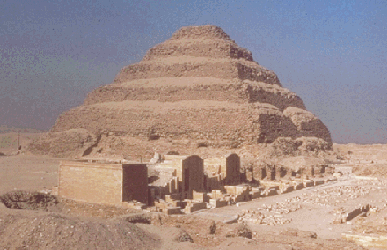
Imhotep, the Architect of the 1st Pyramid
Imhotep was also the "priest of Heliopolis," the biblical On. Now in the story of Joseph, we learn that his father-in-law was the "priest of On" at the time of Joseph's marriage:
- "And Pharaoh called Joseph's name Zaphnathpaaneah; and he gave him to wife Asenath the daughter of Potipherah priest of On. And Joseph went out over all the land of Egypt." Genesis 41:45
Since Asenath was old enough to marry Joseph at this time, it follows that her father was probably at least in his forties. In ancient Egypt, the people didn't live too much longer than about 50. At his death or disability, it follows that his son-in-law would be assigned his position, especially if that son-in-law were so highly regarded by the pharaoh as Joseph was.
If Joseph became the "Priest of On," was he being unfaithful to the true God? Absolutely not -- the pharaoh had recognized the power of the God of Joseph, and even though the Egyptians remained idolaters, Joseph made them aware of his God and was unswerving in his loyalty to Him. The "Priest of On" was not termed the priest of a particular god -- but the title instead seems to indicate a position of high honor and political importance.
It was Imhotep who is credited with having designed the first pyramid (above) and began building with hewn stone instead of all mud brick. If we look at ancient Egyptian history, we can see evidence which shows that it was during the time of Djoser that Egypt became a truly great nation -- since it had gathered the wealth of all the surrounding nations by selling them grain during the famine.
And during the seven years of plenty, the people, under Joseph's wise guidance, began to organize a great administrative center which would handle the selling of the grain to all the surrounding nations.
Imhotep - the Physician
Imhotep is the earliest physician whose historical records survive, and although Joseph isn't mentioned as being a physician, the Bible gives one very important clue to this:
- "And Joseph commanded his servants the physicians to embalm his father: and the physicians embalmed Israel." Genesis 50:2
The Wisdom of Imhotep
The Biblical account also speaks of Joseph's wisdom:
- "And Pharaoh said unto Joseph, Forasmuch as God hath shewed thee all this, there is none so discreet and wise as thou art." Genesis 41:39
Again, the evidence points to Imhotep. Imhotep was also revered for his wisdom. In several inscriptions from much later times, reference is made to the "words of Imhotep." For example, in "Song from the Tomb of King Intef," we read: "I have heard the words of Imhotep and Hardedef...", and it goes on to explain that their "sayings" were recited in his day.
We know that the wisdom of Joseph came from the true God of Abraham. Would it not be expected that Joseph would pass on his wisdom from God to those around him? In fact, the Bible says that he did:
- "He sent a man before them, even Joseph, who was sold for a servant... The king sent and loosed him; even the ruler of the people, and let him go free. He made him lord of his house, and ruler of all his substance to... teach his senators wisdom." Psalms 105:17-21
Grain Storage Bins
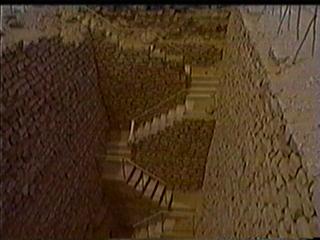 |
 |
 |
 |
In the Biblical account, we learn that Joseph appointed men throughout the land of Egypt to oversee the gathering and storing of the grain in all the cities:
- "Let Pharaoh do this, and let him appoint officers over the land, and take up the fifth part of the land of Egypt in the seven plenteous years. And let them gather all the food of those good years that come, and lay up corn under the hand of Pharaoh, and let them keep food in the cities." Genesis 41:34-35
Joseph had given this plan to the pharaoh prior to his appointment as vizier or prime minister, and since it would be impossible for him to oversee the gathering and storing for the entire country, we know he implemented this plan. We also know that when the famine began and the Egyptians began to cry for food, they were told to go to Joseph and do whatever he said, which indicates that he gave the orders for the distribution of the grain:
- "And when all the land of Egypt was famished, the people cried to Pharaoh for bread: and Pharaoh said unto all the Egyptians, Go unto Joseph; what he saith to you, do. And the famine was over all the face of the earth: and Joseph opened all the storehouses, and sold unto the Egyptians; and the famine waxed sore in the land of Egypt." Genesis 41:55-56
But when the foreign peoples came to purchase grain, we learn that they went directly to Joseph:
- "And Joseph was the governor over the land, and he it was that sold to all the people of the land: and Joseph's brethren came, and bowed down themselves before him with their faces to the earth." Genesis 42:6
Joseph's brothers came directly to Joseph in person. We believe it is Sakkara to which they came -- where the remains of this fantastic complex are preserved. And it was here that Djoser had eleven extremely large pits constructed which can only be grain storage bins.

For more text, facts and pictures, please visit the adress at the end of this page
Back to the top
The crucifixion of Christ and the Ark of the Covenant

The crucifixion site of Christ is located between the Garden Tomb and Golgotha (interpreted "The place of a skull"). In the right of the picture, You can see the part of a face.
"The rocks were rent...." Matt. 27:51
Above the cut-outs near the Garden Tomb is a large crack in escarpment extends up the face, behind the point where Christ was crucified. Lower portion of crack has been filled-in to prevent erosion.
Note: Nowhere it is written, that they brought Jesus upon a hill, like the scene in the movies.
"And they bring him unto the place Golgotha, which is, being interpreted, The place of a skull." Mark 15:22
 |
The Ark of the Covenant had been secreted into this cave in 586 BC when the Babylonians had Jerusalem under siege (II Kings 25). Jeremiah and his assistants wished to hide the furnishings of the tabernacle from the pagan invaders. But in reality this was part of God's plan. If the Jews had accepted Christ as the Messiah, the Jews would have had possession of the Ark at the time of Christ and would have offered Jesus' blood as the final sacrifice and would have placed His blood on the Ark. But God knew they would not accept His Son, so He had His own plan arranged to place the blood of His Son on the Most Holy, the Ark of the Covenant. When Christ died, "the rocks were rent" (Math. 27:51), creating the crack in the bedrock leading down into the cave below. A Roman soldier speared Christ's left side, causing blood and water ((John 19:34)) to flow through the crack into the cave below. The lid of the stone case containing the Ark of the Covenant was broken and moved aside allowing Christ's blood to flow directly onto the Mercy Seat of the Ark. At this moment type met antitype. Both the old and new covenants were ratified by the blood of Jesus. The ceremonial system which looked forward to Christ's sacrifice came to an end. At that moment the large, thick veil in the temple was torn by God from top to bottom and the sacrificial Passover lamb escaped, as Jesus was the final sacrifice. Ron Wyatt took a sample of blood from the mercy seat and analyzed that in a laboratory in Israel. This human blood only has 24 chromosomes in it. Everybody else has 46. 23 from your mother and 23 from your father. 22 autosomes from the mother, 22 autosomes from the father. This blood had 23 chromosomes from the mother’s side, and only one Y chromosome. |
I (Wolfgang) asked Mr.Kevin Fisher from Arkdiscoveriy.com, why don't exist a photo of the "Ark of the Covenant"?
And he wrote me back this: "The photos are not allowed to be viewed by the public since the angel in the cave said the ark would be revealed when the Mark of the Beast law is enforced. So we are waiting until that event to see actual video."
For more text, facts and pictures, please visit the adress at the end of this page
Back to the top
The real Mt.Sinai in Saudia Arabia
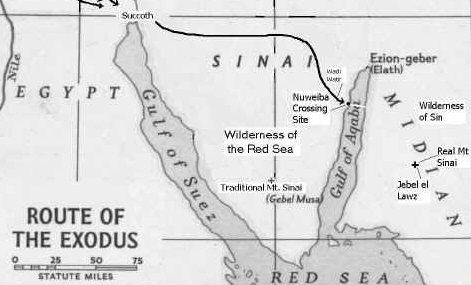
In the third month after the children of Israel were gone forth out of the land of Egypt, the same day came they into the wilderness of Sinai. And when they were departed from Rephidim, and were come to the wilderness of Sinai, they encamped in the wilderness; and there Israel encamped before the mount. Exodus 19:1-2
On the western or back side of the mountain is Rephidim where Moses and the Children of Israel first encamped before reaching Mt. Sinai. It was here that Moses struck the rock, above, which gushed forth large quantities of water. The giant 60 foot rock is on a 300 foot tall hill, and has obvious signs of water erosion, yet it is located in this desert region. The fissure in the rock is so large that you can walk easily through it.

Vanity Fair Magazine published a large article on the discovery of this mountain in the February 1998, issue, and featured many photos.
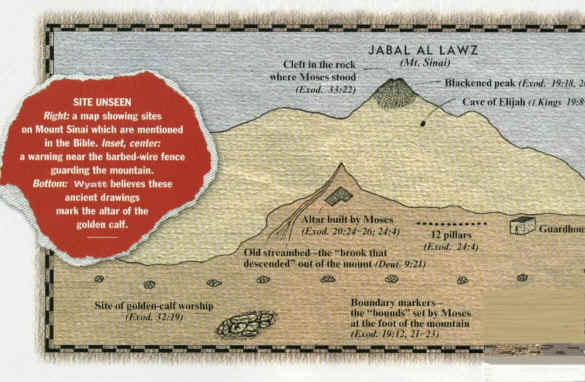
Mr. Wyatt is the original modern-day discoverer of the real Mount Sinai. The upper 200 feet of Jebel el Lawz is burned black, as we have seen in previous photos above. The Saudi Government will confiscate any photographs of the mountain and will not allow any tourists into the country, but U.S. Government satellite photos and a few private photos smuggled out of the country reveal the secret mountain by its unique blackened peak.
A dozen giant boulders are stacked in the encampment area and reveal 12 ancient Egyptian petroglyphs of bulls. It is believed the golden calf was placed upon these rocks. Large altars are found on the east and west sides of the mountain.
Back to the top
Back to "The way to God " and the other storys.
For all text, facts and pictures, thanks to arkdiscovery.com



